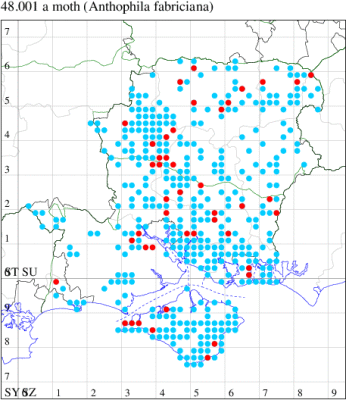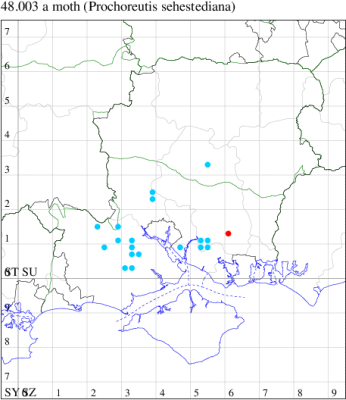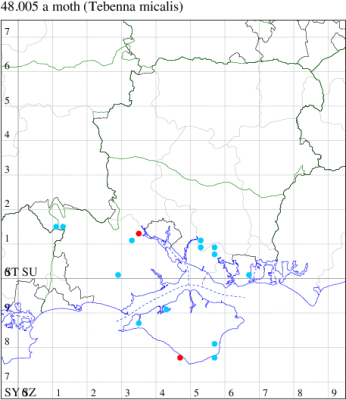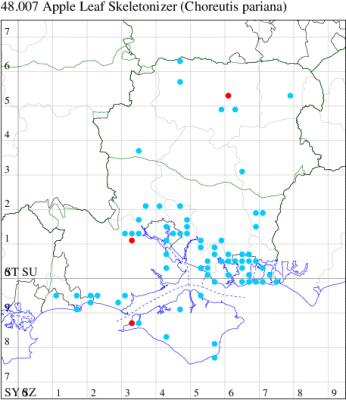2021 Annual Report for: Choreutidae / Choreutinae
For species seen in 2021 that had less than or equal to 100 records, full details are included; for more common species, the earliest, latest and highest count by vice-county are shown. The narrative for each species is taken from the main Hantsmoths website, and it is possible that some information on abundance and occurrence can get out of date, as it is impossible to keep up with all changes; however it should give a good introduction to each species. The tables in each species account summarise the previous status, and that for the current year.
For the maps, all records prior to 2021 are shown by a blue dot (the larger the dot, the more recent), with the current year's records shown in red. As previous records are superimposed on any report for 2021, new sites have greater emphasis (i.e. will show as 'more red').
In the species accounts, an asterisk next to a location indicates a new 10km square record; earliest ever dates are highlighted in orange, and latest ever in red. Initials in the species accounts refer to the recorders listed here. Please get in touch if you identify any omissions or errors, in particular if you have records that have yet to be submitted. Details of how to submit records can be found here.
48.001 [B&F: 0385] Anthophila fabriciana (Linnaeus, 1767) - Common
Common on waste ground, hedgerows and gardens throughout the British Isles. In Hampshire and on the Isle of Wight often abundant during the day, wherever stinging nettles grow. Wingspan 11-15 mm. Day-flying. The main confusion species is Apple Leaf Skeletoniser Choreutis pariana, which is without whitish markings except along costa, while the closely related Prochoreutis are marked with silvery spots (MBGBI Vol 2). Larva feeds on Stinging Nettle, Small Nettle and Pellitory-of-the-wall.
Records prior to 2021
| Vice County | #Records | #Individuals | First Record | Last Record |
|---|---|---|---|---|
| 10 | 288 | 1146 | 1971 | 2020 |
| 11 | 751 | 1247 | 1966 | 2020 |
| 12 | 526 | 1739 | 1974 | 2020 |
2021 records
| Vice County | #Records | #Individuals | Max Quantity |
|---|---|---|---|
| 10 | 11 | 62 | 20 |
| 11 | 24 | 25 | 4 |
| 12 | 35 | 63 | 9 |

Records by year
Records by week (adult)
Records by week (larval)
Record Details
VC10: Headon Warren & Undercliff, three, field observation, 26 Jun (DCoo); Totland, two, field observation, 27 May; one, field observation, 01 Jun; one, 03 Sep (RTer); Farringford, 20, field observation, 25 May; Freshwater, 20, field observation, 09 Jun (DCoo); Afton Marsh, one, to pheromone lure, nUN Lure, 07 Jun (SDav); Brook Down, seven, field observation, 05 Jun; Newtown NNR, three, field observation, 23 Aug (DCoo); Ventnor Botanic Garden, one, field observation, 05 Jul (PBar); Holme Copse, Shanklin, three, field observation, 26 Jun (IOut);
VC11: Marchwood, one, field observation, 29 May (TDCh); one, 06 Sep (CTha); Woodlands, NF, present, 30 May (RBW); Totton, one, field observation, 26 Sep; one, field observation, 19 Oct (LHan); Winter Down Copse, Little Somborne, one, 07 Oct; Crawley, one, 14 Sep (GCE); Eastleigh, one, field observation, 04 Oct (AMur det. MJW); Wildern LNR, Hedge End, one, field observation, 16 Oct (TCrw); Hocombe Mead LNR, Chandlers Ford, one, field observation, 04 Oct (AMur); Twyford, one, swept, twyford Meads, 19 Jul (RJD); Crawley, two, 14 Sep (GCE); Botley, one, 29 Jul (SLB); Dean, nr Bishops Waltham, present, field observation, 09 Nov (DTru); Hilltop, The Hangers, one, field observation, 12 Jun (SIng det. DPH); Upper Swanmore, present, field observation, 22 Sep (DTru); Great Salterns NR, Portsmouth, one, field observation, 30 Sep (MRY, JRL); Milton Common, two, field observation, 12 Oct; West Walk, one, attracted to blossom, on Pulicaria flower, 06 Sep (RJD); Old Winchester Hill, one, field observation, 05 Jul (MCha); one, attracted to blossom, on hogweed blossom, 05 Jul (RJD); Buriton, four, field observation, 22 Jun (ALaw); Petersfield, one, 19 Jun (RAll); Merritown Heath, present, 28 May (DFoo);
VC12: Chilbolton, one, 09 Sep (GCE); The Hawk Conservancy Trust, Weyhill, two, field observation, 26 Jun (MJhn); Crawley, one, 14 Sep; one, 14 Sep; one, 25 Jun; one, 07 Sep; Barton Stacey, one, 12 Oct; one, 24 Sep; one, 24 Sep; one, 24 Sep (GCE); Old Burghclere, two, field observation, 06 Jun (GJD); Ladle Hill, one, field observation, 16 Jun (DKel); Cheesefoot Head, one, field observation, 24 Jun (SRP); Kempshott, one, 04 Sep (GAH); Overton, one, field observation, 05 Jul (PEH); Ecchinswell, one, field observation, 28 May; one, field observation, 08 Jun; nine, field observation, 10 Jun; three, field observation, 11 Jun; six, field observation, 26 Jun; two, field observation, 29 Jun; five, field observation, 05 Jul; two, field observation, 07 Jul; two, field observation, 13 Sep (MJN); Basingstoke, one, field observation, 13 Oct (JEH); Basing Forest, one, field observation, 30 Jun (MDuf); Rotherwick, present, field observation, 18 Sep (AWhi det. AWhi); Minley Wood, one, field observation, 14 Jun; one, field observation, 22 Jun; one, field observation, 03 Aug; three, field observation, 05 Sep; one, field observation, 06 Sep; three, field observation, 15 Sep; two, field observation, 16 Sep; Blackwater, one, 26 Sep (BDal)
48.003 [B&F: 0387] Prochoreutis sehestediana (Fabricius, [1777]) - Nationally Scarce B
Nationally scarce (Nb) in damp grassland and moorland in parts of southern England and western Scotland, where distinctly less common than P. myllerana. In Hampshire chiefly in the New Forest, and also found at Ampfield Wood and Botley Wood, but very rare in the north of the county, where there is just one old record. Not recorded from the Isle of Wight to date. Wingspan 9-12 mm. Day-flying. Very similar to P. myllerana, which see for difference. Larva feeds on Skullcap and Lesser Skullcap.
Records prior to 2021
| Vice County | #Records | #Individuals | First Record | Last Record |
|---|---|---|---|---|
| 11 | 48 | 180 | 1929 | 2020 |
| 12 | 1 | 1 | 1973 | 1973 |
2021 records
| Vice County | #Records | #Individuals | Max Quantity |
|---|---|---|---|
| 11 | 1 | 1 | 1 |

Records by year
Records by week (adult)
Records by week (larval)
Record Details
VC11: West Walk, one, attracted to blossom, gen det, 06 Sep (RJD)
48.005 [B&F: 0386] Tebenna micalis (Mann, 1857) - Migrant
Rare immigrant from southern Europe to the south coast of England, in some years appearing in sufficient numbers to breed but apparently not able to establish itself in Britain. In Hampshire first recorded in 2002 at West Park (VC8), but not again until 2014 when a significant influx brought 8 records to both counties, since when there have been further reports and it looks likely to be expected to become an increasingly frequent visitor to our shores. Wingspan 11-14 mm. Distinctively marked, claims from Hampshire and Isle of Wight should be accompanied by photographic or other evidence. Larva mines leaves of Common Fleabane.
Records prior to 2021
| Vice County | #Records | #Individuals | First Record | Last Record |
|---|---|---|---|---|
| 10 | 4 | 4 | 2014 | 2017 |
| 11 | 7 | 7 | 2014 | 2015 |
2021 records
| Vice County | #Records | #Individuals | Max Quantity |
|---|---|---|---|
| 10 | 1 | 1 | 1 |
| 11 | 1 | 1 | 1 |

Records by year
Records by week (adult)
Records by week (larval)
Record Details
VC10: Chale, one, field observation, 12 Jul (PBar);
VC11: Totton, one, 12 Sep (LHan)
48.007 [B&F: 0389] Apple Leaf Skeletonizer Choreutis pariana (Clerck, 1759) - Local
Local in orchards, gardens and hedgerows throughout Britain. Most records in Hampshire are from the extreme south-east corner of the county, with very few records from north Hampshire or the Isle of Wight, and the species is possibly overlooked in these vice-counties. Wingspan 11-15 mm. Very variable but easily recognised by its brown colouring, usually with bright red-brown cilia, and absence of silvery markings (MBGBI Vol 2). Day-flying. Larva feeds on the foliage of Apple, Crab Apple and various fruit trees, causing sufficient damage to be a serious pest in some areas.
Records prior to 2021
| Vice County | #Records | #Individuals | First Record | Last Record |
|---|---|---|---|---|
| 10 | 9 | 9 | 2000 | 2020 |
| 11 | 184 | 174 | 1974 | 2019 |
| 12 | 9 | 7 | 1986 | 2018 |
2021 records
| Vice County | #Records | #Individuals | Max Quantity |
|---|---|---|---|
| 10 | 1 | 1 | 1 |
| 11 | 1 | 0 | 0 |
| 12 | 1 | 1 | 1 |

Records by year
Records by week (adult)
Records by week (larval)
Record Details
VC10: Freshwater, one, 06 Sep (DCoo);
VC11: Woodlands, NF, present, 04 Aug (RBW);
VC12: Basingstoke, one, field observation, settling on black medick flowers, 16 Sep (MJW)
48.0071 [B&F: 0389a] Choreutis nemorana (Hübner, 1799) - Adventive
Reported as new for Britain when it was reared from a fig tree Ficus carica in Hyde Park, London, July 2014 (de Prins, Ent Rec J Var 126:157). Now expanding in range across the south of England.
In our area, found for the first time on 5th November 2021, when Iain Outlaw found the pupae of this species on Fig (Ficus carica) in the front garden of a now abandoned hotel in Shanklin, in leaves with feeding signs and folded edges. Inside the folds there were tough silk cocoons with an outer layer binding to the leaf and an inner layer containing a pupa. At the end of the inner layer was the final larval skin. One folded leaf showed an exuxium, presumably left when the adult emerged. That cocoon was examined and found to be vacated. Found to be relatively common around the coast of the island in 2022, and further expansion saw the first record for Hampshire in 2023, near Lymington, and a number more in 2024 along the south coast.
Records prior to 2021
| Vice County | #Records | #Individuals | First Record | Last Record |
|---|
2021 records
| Vice County | #Records | #Individuals | Max Quantity |
|---|---|---|---|
| 10 | 2 | 0 | 0 |

Records by year
Records by week (adult)
Records by week (larval)
Record Details
VC10: New Vice-county Record: Shanklin, pupa, present, field observation, occupied and vacated cocoons on Ficus carica: several pupae collected to breed through, 05 Nov; pupa, present, field observation, additional cocoons collected from the tree in Queens Road, 06 Nov (IOut)
